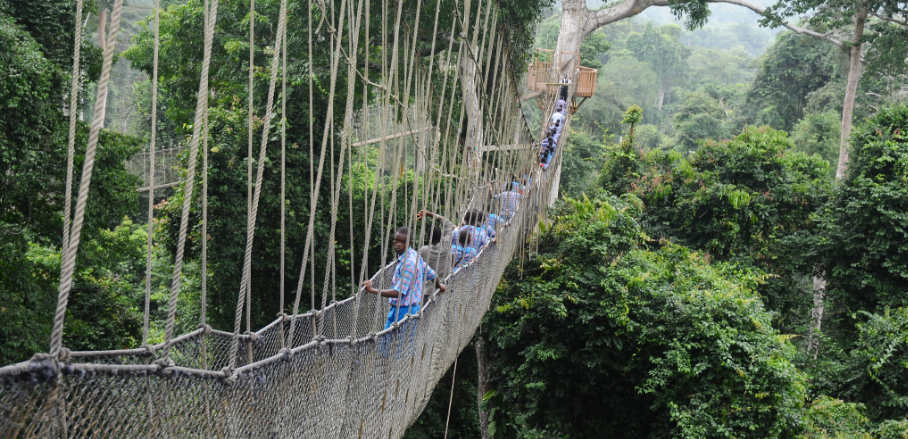Applying Ancestral Lessons to Contemporary Realities – A Return to Ghana’s Architectural Heritage
Breathing new life into city architecture through native materials and construction techniques will catalyse lasting change and adaptability amidst unpredictable climate change-related incidences—Kweku Addo-Atuah on a return to Ghana’s architectural heritage.
Heat, dryness, rainfall, and humidity collide with coastlines, mountain ranges, rivers, swamps, and marshes to make up Ghana’s natural world. Together, these geophysical conditions also constitute Ghana’s architectural legacy – from traditional typologies and colonial architectures to such styles as tropical modernism – and etch themselves into the Ghanaian built environment. These stylistic shifts, often on the heels of socio-political upheavals – colonial and postcolonial eras – speak to the lingering effects of the country’s thirst for imposed materials like concrete as synonymous with modernity, cultural evolution, and infrastructural maturity. It is the desire of satiating this thirst, and the misguided pursuit of ‘recognition’ by mainstream architecture circles alongside the influx of expatriates and tourists that results in thousands of uncompleted structures across Ghana’s urban and rural areas.
Extensive Use of Concrete Contributes to Climate Crisis
Ghana’s dealing with concrete is not exceptional. In fact, the material has extensive use in construction worldwide due to its durability, strength, and fire resistance. However, this comes at a cost: concrete-related architectural and landscape architectural construction contribute roughly eight per cent of the total carbon dioxide emissions globally. Aside from the laborious production process and its enormous energy consumption demand, this popular material sharply undercuts the liveability and microclimatic comfort of many building occupants in subtropical and tropical countries like Ghana. The onslaught of climate change-induced phenomena in both industrialised and industrialising countries – increased flooding, hotter summers, rapid glacial melts, drought frequency, and rising seas – all point to a crisis of human conscience and culpability. Hence, among others, built environment professionals must uphold their mandate of being more intentional and inventive with materiality in project proposals.
The Birth of a New Architectural Lineage
For Ghana, it means a swift return to its vast wealth of local building materials and construction techniques, being itself distinct across its three biome subdivisions: the hot coastal southern belt, the humid rainforest middle belt and the dry savannah northern belt. A return to Ghana’s architectural heritage indicates design responses traced from its immediate context, which determines every aspect from roof shape and angle to solar exposure, the density of material stacking, and the thickness of a building’s wall. It means a sensitive reading of the site and the sometimes competing biological, geophysical, sociocultural, and historical conditions that have influenced and continue to influence the site. It is not a mere copy of bygone ancestral design material and construction methods such as placing timber or laterite or even an atakpamé wall system in ecological settings where its benefit proves negligible.
Rather, it is a deliberate process of deconstructing, reconstructing and reframing centuries-old practices, analysing similar constraints and opportunities of past eras, and diligently applying these lessons to contemporary realities. How do we industrialise this abandoned local material or wall interlocking system? What does it look like within the 21st century and beyond? How do we ensure its mouldability and structural integrity in extreme weather conditions of severe heat or 100-year flood events? Grappling and iterating through design prompts and conditions such as these is what leads to mature, context-sensitive transformation and charts a new architectural lineage for Ghana. It is through such analyses, alongside woven histories, and the development of new spatial and policy practices that a culturally-resonant built environment will emerge across Ghana’s three distinct but increasingly overlapping ecological zones.

Accra © Ben Freeman
The Need for a Resilient Framework
A resilient Ghana, and its ability to absorb and anticipate shocks, and reform anew, go beyond specifying native materials and techniques to reduce the building sector’s contributions to global emissions. For Ghana, a resilient future necessitates an avant-garde approach to national development, blending old and new technologies to ensure continued growth. Long gone are disproportionate investments in the coastal and middle belts whilst the northern savanna zones flounder, especially when some of the country’s most prominent projects that reference indigenous design forms and typologies originate from these regions. The expected positive results from deploying native materiality and techniques with low embodied energy only become plausible when they are guided by government-directed infrastructural networks that connect all of Ghana. Multi-modal transportation, water, energy, sanitation and drainage facilities, healthcare, education, and multi-income housing constitute the principal ‘building blocks’ for an ecologically, economically, and socially responsible Ghana.
Honouring Local Knowledge
Findings within these infrastructural linchpins include better siting strategies of buildings for such purposes as passive energy and flood protection, as well as opportunities for new industrial and socio-spatial models to emerge at the city, town, and village levels. It is this level of integration, whilst providing choice in ways of living, working and leisure throughout Ghana that will foster lasting transformative impact. As griots – traditional West African storytellers – serve as the oral archaeologists of a people’s history and culture, so too must designers, planners, and engineers serve as physical translators of Ghana’s histories, cultures, and artistic practices. These professionals must pull from the knowledge of local populations to produce outstanding architectural and infrastructural works that embody the values of these communities, towing the past, present and future in elegant displays of craftmanship, meaning, and communal reverence.
